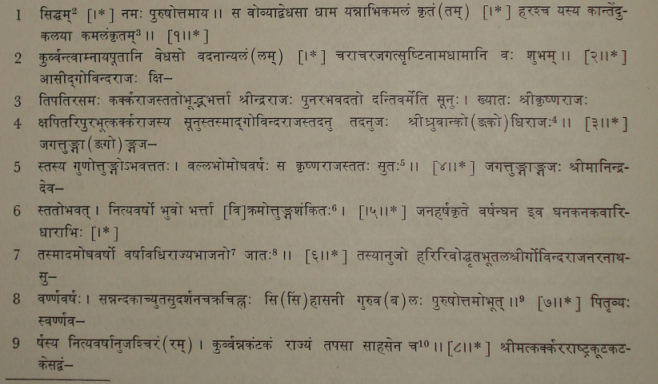|
The Indian Analyst
|
North Indian Inscriptions |
INSCRIPTIONS OF THE SILAHARAS OF NORTH KONKAN
Verse 46 mentions Ammaṇaiya as an Amātya of the king, and Jhañjapaiya as his Sāndhivigrahika. The Kāyastha Uddāma, son of Chakkaiya, was the scribe. ..As for the localities mentioned in this grant, Saṁyāna, which was conquered by Aparājita, is modern Sanjān in the north of the Thāṇā District. It was preciously under the rule of an Arab feudatory of the Rāshṭrakūṭas. Puṇaka-dēśa corresponds to the modern Poonā District. Saṅgamēśvara and Chapulaṇa still retain their old names and are situated in the Ratnāgiri District. Lāṭa is the ancient name of Southern Gujarāt. The country of Bhillama is the kingdom of the Yādavas in Khāndesh. Chandrapura was probably the capital of the Chandra-maṇḍala mentioned in the Khārepāṭan plates and can be identified with Chāndor in South Goa. Mānyakhēṭa, the well-known capital of the Rāshṭrakūtas, is, of course, Mālkhed, and Karahāṭa is modern Karhāḍ in the Sātārā district. Palachchha-uchchhikā may be identical with Pālē, about three miles east of Muruḍ. Vihalē, the chief town of the territorial division in which the donated village was situated, may be Vihuli in the adjoining Māṇgaon talukā of the Kolābā District. Chikkhalāḍa, the chief town of the vishaya (district) which included these places may be identical with modern Chikhalgaon, about 8 miles north of Muruḍ. Majjigrāma, which formed the western and northern boundaries of the donated village, is undoubtedly modern Mājgaon, about 4 miles north of Muruḍ.
TEXT[1]
[1] From the facsimiles (Plates V-VIII) in Important Inscriptions from the Baroda State.
|
|||||||||||||||||||||||||||||||||||||||||||||||||||||||||||||||||||||||||||||||||||||||||||||||||||||||||||||||||||||
| > |
|
>
|








